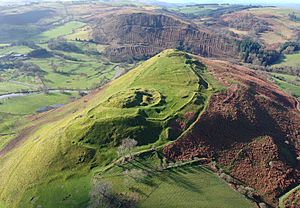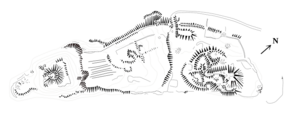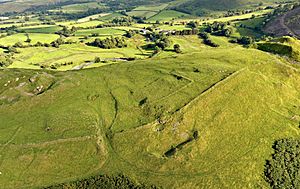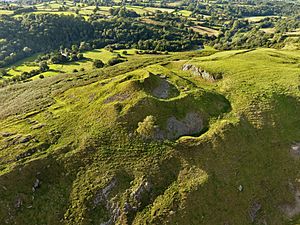Cefnllys Castle facts for kids
Quick facts for kids Cefnllys Castle |
|
|---|---|
| Castell Cefn-llys | |
| Powys, Wales Near Llandrindod Wells |
|

Castle Bank from the north
|
|
| Coordinates | 52°14′38″N 3°20′07″W / 52.2438°N 3.3353°W |
| Type | Spur castle |
| Height | 304 metres (997 ft) above sea level |
| Site information | |
| Open to the public |
Yes |
| Condition | Ruined |
| Site history | |
| Built | c. 1093–95 (motte-and-bailey castle) c. 1242 (first masonry castle) 1273–74 (second masonry castle) |
| Battles/wars | Norman invasion of Wales (1067–1100s) Anglo-Welsh war (1256–67) Revolt of Madog ap Llywelyn (1294–95) Revolt of Owain Glyndŵr (1400–15) |
Official name:
|
|
| Reference #: |
|
|
Listed Building – Grade II
|
|
| Official name: Church of St Michael | |
| Designated: | 12 December 1952 |
| Reference #: | 9301 |
Cefnllys Castle (Welsh: Castell Cefn-llys) was an important medieval castle in Powys, Wales. It was built on a ridge called Castle Bank, high above the River Ithon. This castle was very important because it controlled several routes into central Wales.
The first castle here was made of wood and earth by the Normans around 1093-1095. Later, two stronger stone castles were built on Castle Bank in the 1200s. Cefnllys Castle was a key place during the many conflicts between the Welsh and the English. It was often fought over by powerful leaders like Llywelyn ap Gruffudd, the Prince of Wales, and Roger Mortimer, an English lord.
Today, Cefnllys Castle is in ruins, but you can still see traces of its walls and earthworks. The nearby St Michael's Church is the only medieval building still standing.
Contents
What Does Cefnllys Mean?
The name Cefnllys comes from two Welsh words:
- Cefn means 'ridge'.
- Llys means 'mansion' or 'court'.
So, Cefnllys means 'ridge court' or 'ridge mansion'. A llys was often an unfortified home for Welsh rulers. The name was first written down in 1246 as Keventhles.
An older name for the area was Dinieithon, meaning "fort on the River Ieithon". This name was used for the earlier Norman castle.
Where Was Cefnllys Castle Built?
Castle Bank is a lonely ridge located about 1.7 miles (2.7 km) east of Llandrindod Wells in Powys. It was a perfect spot for a castle because it offered great views over the River Ithon and the valleys around it. This allowed defenders to see anyone approaching.
Cefnllys was the main administrative center for a region called Maelienydd. This area was part of the "middle march," a turbulent borderland between Wales and England. The castle acted as a strong defense against Welsh attacks on English border towns like Hereford.
What Did Cefnllys Castle Look Like?
Castle Bank is a naturally strong place for a castle. It's protected on three sides by a bend in the River Ithon. The highest point is 304 metres (997 ft) above sea level.
There were two castles on Castle Bank, built at opposite ends of the hill. Today, they are mostly piles of rubble, but we can still see their basic shapes.
The Earlier Castle (North-East)
The first stone castle was on the north-east side of the hill. It had:
- A keep (the main tower) inside a triangular inner courtyard called a bailey.
- An outer bailey, which might have had a gatehouse at its north-east corner.
The Later Castle (South-West)
The second, newer castle was built on the south-east side. Its main feature was:
- A round or eight-sided tower within a walled courtyard.
- This area was separated from the rest of the ridge by a deep ditch carved into the rock.
- There was likely a smaller bailey to the south-west.
- A stone wall and rampart (a defensive bank of earth) ran along most of the hilltop.
St Michael's Church is at the bottom of the hill, about 300 metres (980 ft) west of the castle. Some historians believe the medieval town was located around this church. Others think the town might have been inside the castle's defenses on Castle Bank.
A Brief History of Cefnllys Castle
We don't have many archaeological digs at Cefnllys, so most of what we know comes from old writings.
Early Days and the First Wooden Castle
Some people think there might have been an Iron Age hillfort on Castle Bank before the castles. However, there's no strong proof of this.
The first castle at Cefnllys was a wooden motte-and-bailey castle. This means it had a large mound (motte) with a tower on top, and a walled courtyard (bailey) below. It was built by a Norman baron named Ranulph de Mortimer between 1093 and 1095. This started a long connection between the powerful Mortimer family and Cefnllys.
After Ralph Mortimer died around 1104, the Welsh took back control of the area. It remained a disputed territory for many years.
The First Stone Castle (1242)
In 1240, Llywelyn the Great, the ruler of Gwynedd (a powerful Welsh kingdom), died. This created a chance for the English lord Ralph Mortimer II to strengthen his power in the area.
In 1242, Ralph Mortimer II ordered a stone castle to be built or strengthened on Castle Bank. This became the north-eastern castle. It showed how strong the Mortimer family was in Wales.
However, in 1256, a big Welsh uprising began, led by Llywelyn ap Gruffudd, the new Prince of Wales. In November 1262, a small group of Welshmen captured Cefnllys Castle by trickery. They took the castle's guard and his family captive, then burned the castle.
Roger Mortimer, Ralph's son, quickly gathered an army to repair the castle. But Llywelyn surrounded him with a larger force. After a three-week siege, Roger was forced to leave. Llywelyn then destroyed the remaining defenses. This event was a big deal and made many English lords scared.
The Second Stone Castle (1273-1274)
After a peace treaty in 1267, Roger Mortimer was allowed to rebuild Cefnllys Castle. He quickly started building a new and stronger castle on the southern side of the ridge.
Llywelyn ap Gruffudd was not happy about this. He believed the treaty only allowed repairs to the old castle, not a completely new one. He wrote to King Edward I in 1273 or 1274, asking him to stop Roger's construction. Llywelyn saw this new castle as a challenge. This disagreement was one of the main reasons for the war between Llywelyn and Edward I, which led to Edward's conquest of Wales between 1277 and 1283.
Cefnllys Castle was not directly attacked in this war. Instead, it became part of a chain of castles that surrounded Llywelyn's lands.
The castle may have been attacked during the Welsh revolts led by Madog ap Llywelyn (1294–1295) and Owain Glyndŵr (1400–1415). However, it remained in use until at least the mid-1400s.
Over time, castles became less important due to new warfare methods and changing social trends. The Mortimer family line ended in 1425, and the castle was inherited by Richard of York, 3rd Duke of York. He paid for some repairs, but the castle's upkeep was often neglected.
By the early 1500s, the castle was already described as "now downe" (meaning ruined).
The Castle Town of Cefnllys
The Mortimer lords wanted to build a town near Cefnllys Castle to help control the area. We don't know exactly when it started, but it was first mentioned in 1297 when it was given permission to hold a market. By 1304, it was a borough (a town with special rights) and had 25 citizens, a church, and a town mill.
The town was small, remote, and didn't last long. Its growth stopped before 1332, and by 1383, it only had 10 residents. The location, chosen for defense, made it hard for the town to thrive economically. Major outbreaks of the Black Death (a terrible plague) in the 1300s also contributed to its decline.
Even though the medieval town disappeared, Cefnllys kept its borough status until the 1800s. In 1831, it was recorded as having only 16 people living in "three Farm Houses and one small Cottage," besides the church and castle ruins.
Images for kids










